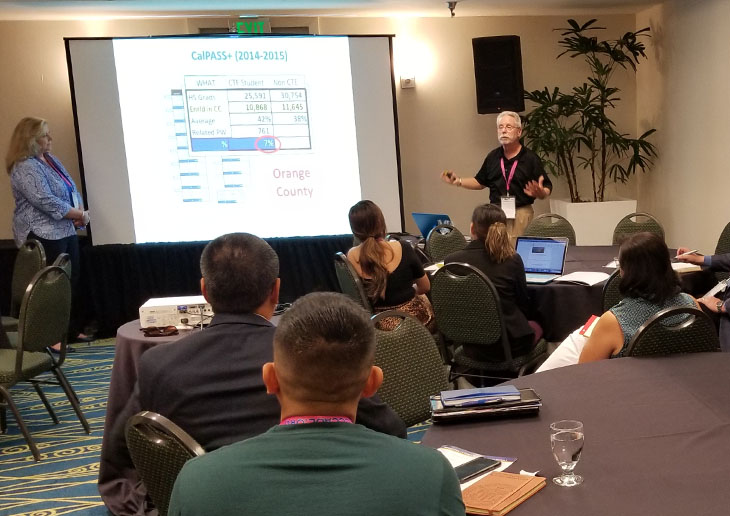Orange County Leads State with Innovative Career Education Tool New Tool
October 31, 2019

With 58 K-12 career education pathways and hundreds of community college programs to choose from, it’s no wonder a high school student might be confused about where their career education journey should start.
This is exactly the problem Orange County Department of Education Workforce Development Consultant Steven A. Glyer and Cypress College Dean of Career Technical Education Dr. Kathleen Reiland set out to solve.
In 2014, Glyer and Reiland noticed a problem: only 8 percent of career education (CE) students who had taken at least 2 classes in a sequence continued in a related field. Something was standing in their way.
Enter Program Finder (www.ProgramFinderOC.com), a simple but powerful tool that allows students, parents, and counselors to browse Orange County’s high school and community college career education programs across 15 unique industry sectors. Developed in partnership with the Orange County Department of Education, Program Finder is the first tool of its kind in the entire state and can be accessed on phones, tablets, and computers alike, making it easier than ever for students to quickly identify a career path that suits their needs.
“The tool uses information from the California Community Colleges Chancellor’s Office, makes it available for everybody, and connects it to these programs,” relates Reiland.
Program Finder is not a career profiler that seeks to align student interests with potential occupations. Rather, it has the simpler, and perhaps more pragmatic, purpose of helping students understand their program options so they can get into the right program earlier. That translates to less wasted time, fewer wasted classes, and a more focused student journey, all of which increase the likelihood of student success. According to Glyer, “This tool is going to help CE students fine-tune where they are going to go next.”
Funded by the California Community Colleges’ Strong Workforce Program and designed by Concentric Sky, a software development studio that has worked with the likes of National Geographic and PBS, Program Finder works by allowing users to work their way down from broad industry sectors to more specific careers and eventually to the community college career education programs that offer degrees and certificates in those fields. In three clicks, a student interested in becoming a firefighter can find every community college and high school dual-enrollment program in the region offering an educational pathway to that career.
As an added bonus, programs are displayed on an interactive map so users can determine which locations best fit their geographic needs. When a program piques their interest, they can click on the college or school district and go directly to a program page for more info.
“This tool equips a high school CE teacher with the ability to say to students, ‘Hey, let’s see what kinds of programs you might want to go to at one of the colleges here in OC,’” says Glyer.
In addition to helping students, high school counselors, who previously had to fumble through numerous websites and random print materials to figure out which programs were at which schools, now have a single resource they can use to guide students to all of the regional programs that suit that student’s needs and interests. And, because the tool works dynamically on smartphones, tablets, and desktops, it will be easier than ever to empower students to take control of their futures.
“The student will be able to go home, show mom and dad, and have a discussion about what they might want to do,” Glyer adds.
In addition to the advantages this convenience provides to prospective students and high school counselors, specialized backend features allow college faculty, deans, and outreach counselors to track program enrollment trends and see how many high school students are already in the educational pipeline. This will improve the ability of Orange County’s community colleges to connect their career education opportunities with evolving industry and workforce demand, while also improving their ability to target their outreach efforts.
For instance, if a college is having a career day for manufacturing jobs, they can quickly and easily identify which regional high schools are worth inviting. All they need to do is click on the “Manufacturing and Product Development” category, click on the “Manufacturing and Industrial Technology” tab, and view the 14 high school districts that offer programs related to the field. From there, following links to the schools’ websites will provide all the information outreach personnel need to know who to contact to best promote the event. Soon, there will be contact information added for district Career Coordinators, making collaboration between K-12 and colleges even easier.
“The Program Finder tool will be a game changer for outreach efforts for the OC community colleges,” says Raquel Requena Ramirez, Student Services Coordinator at Santa Ana College. Ramirez is excited that the tool will allow her to search for high schools that offer the specific programs they are trying to highlight or promote at the college. “Instead of calling around and sending numerous emails, I can search for this information myself and gather answers in seconds,” says Ramirez.
In addition to blazing a trail in Orange County, it’s also leading the way across California. Glyer and Reiland will be presenting Program Finder across the state and have already figured out how to make Program Finder replicable at a low cost for other districts.
“The Chancellor’s Office is watching this and saying, ‘Hmmm, could we do a state-wide version of this?’” Glyer relates. “But as of right now, the only game in town is in OC.”
To try out this powerful new tool, visit www.ProgramFinderOC.com.




